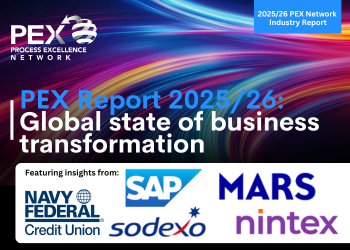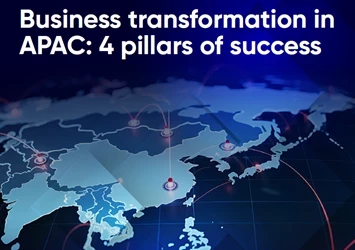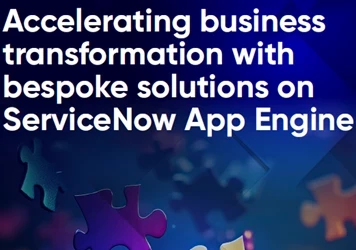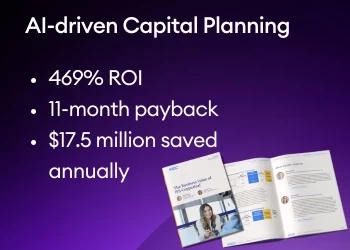Business transformation in APAC: Trends, challenges & opportunities
Business transformation has evolved into a fundamental imperative for survival and sustainable growth in the Asia-Pacific region
Add bookmark
Business transformation is a fundamental imperative for survival and sustainable growth in the Asia-Pacific (APAC) region.
Transformation can no longer be treated as a reactive strategy. Driven by rapid technological innovation, shifting workforce dynamics, climate pressures and increasingly sophisticated consumer expectations, the landscape in which organizations operate has become more complex, interconnected and volatile.
The PEX Report 2025/26 compliles the results of a survey of more than 200 global professionals on various aspects of business transformation. The findings illustrate several key trends, challenges and opportunities for APAC organizations navigating the complex transformation landscape.
Join the PEX Network community

Don't miss any news, updates or insider tips from PEX Network by getting them delivered to your inbox. Sign up to our newsletter and join our community of experts.
Learn MoreAPAC business transformation trends
A third of APAC respondents define business transformation as improving processes/process efficiency (33 percent), followed by artificial intelligence (AI) driven innovation (20 percent), growth and revenue (20 percent) and digital transformation (13 percent). Smaller numbers define it as adopting new technology (7 percent) and organizational redesign (7 percent).
Less than half of businesses (42 percent) are deploying business transformation at one or more business units, followed by a third (33 percent) that are doing on an enterprise-wide scale (compared to 56 percent globally). A quarter (25 percent) have trained process improvement resources but no formal transformation program.
Transformation programs that span the whole enterprise are about three-times more likely to hit their targets than siloed efforts, according to multiple cross-industry surveys, says Ricardo Henriques, transformation leader, business automation professor at Católica Lisbon School of Business and Economics and PEX Network Advisory Board member.
Business transformation is becoming mission-critical
More than half of those polled (58 percent) consider business transformation as mission-critical strategy to help the organization to drive growth, manage turnaround and deliver strategic objectives (level with global findings). This is ahead of a way to automate processes (42 percent) and a way to improve productivity and efficiency (25 percent).
“One of the standout findings from this year’s survey is the 11 percent jump in respondents who see business transformation as a mission-critical strategy for the organization [compared to last year],” says Katie Curry, managing director, head of operations, Multifamily LeaseTrack at MSI and Advisory Board member. “This is a major change reflecting the wider use of AI, which now opens a whole different way to achieve business transformation and achieve results.”
Executive committees are the leading sponsors of business transformation in APAC firms, cited by 42 percent of respondents (versus 24 percent globally). This is followed by chief executive officers (CEOs) (17 percent), chief transformation officers (9 percent) and chief information officers (CIOs) (9 percent). CEOs are the leading transformation budget holders (33 percent).
Register for All Access: AI in Business Transformation 2025!
Business transformation measurements, methods and tools
Customer acquisition and retention is the leading measure of success for business transformation (33 percent) ahead of business top-line growth (17 percent), cost savings (17 percent) and increased throughput/efficiency (17 percent).
APAC firms use advisors and consultants (45 percent), Agile (27 percent) and change management (27 percent) methods to support business transformation. As for technologies, digital transformation tools (45 percent) are the most popular, followed by business intelligence and data analytics, business process reengineering and low-code/no-code automation. Globally, business process management (BPM) is the leading tool used to support transformation (53 percent).
Join us at All Access: OPEX Operational Excellence 2025!
APAC business transformation opportunities
More than half of respondents (55 percent) expect their business transformation budget to increase in the coming year (compared to 25 percent globally). Just under a fifth (18 percent) expect it to remain flat, with 27 percent unsure.
Most businesses are planning to increase investment in AI and generative AI in the coming year (65 percent), with the same percentage also looking to spend on workflow automation (45 percent). This is ahead of data analytics and business intelligence (36 percent), intelligent automation (36 percent) and agentic AI (27 percent).
The three leading business transformation focus areas for the next 12 months are AI adoption (64 percent), creating a culture of transformation (45 percent) and change management (36 percent). Interestingly, almost two-thirds of APAC respondents rate their organization’s ability to drive tangible value from AI adoption as either very high or high (45 percent and 18 percent respectively, compared to 20 percent and 26 percent globally).
Register for All Access: AI, Data & Analytics 2025!
APAC business transformation challenges
Adopting and deploying new technologies, ensuring a customer-centric focus throughout the business and lack of alignment between business and IT departments are the leading business transformation challenges, each cited by 45 percent of respondents. This is followed by sustaining change (36 percent) and change management (27 percent).
Lower down the list are leadership buy-in, overcoming resistance and access to required skills and talent, all around 18 percent.
Globally, the biggest business transformation challenges are cost and budget limitations (58 percent), change management (39 percent), adopting and deploying new technologies (37 percent) and linking process improvement with top-level business strategy (33 percent).
APAC respondents say more skills in digital transformation (73 percent), AI (64 percent), operational excellence (OPEX)/process excellence (45 percent) and leadership (45 percent) would help their businesses stay competitive.
“The findings line up with what I’ve seen time and time again,” says Jeff Winter, digital transformation thought leader and Top LinkedIn Voice. “AI (especially recently), OPEX and digital transformation top the list, not because they’re easy, but because they’re visible. They’re the goals everyone rallies around, but to really understand what is happening, you need to lift the hood. Strategy execution, leadership and change management – these are almost always where the real gaps are, and they are the ones that make or break transformation.”
AI adoption in APAC
Despite confidence in AI adoption, more than half of those polled (55 percent) say that AI initiatives are only somewhat aligned with overall strategic goals, dropping to 27 percent for fully aligned. High cost of implementation (64 percent), data quality and availability (64 percent) and lack of internal expertise (55 percent) are the greatest barriers to AI adoption.
Better data infrastructure (55 percent), strategic guidance (45 percent) and training programs for employees (36 percent) would enable businesses to more effectively implement AI, according to the survey.
“Driving real business value from AI requires the entire ecosystem to work together,” says Sana Zia Hassan, senior manager – AI at EY. “It starts with aligning AI efforts to clearly defined business goals, whether it’s boosting revenue, cutting costs or improving decision making.” That alignment ensures AI is solving meaningful problems, not just running in technical isolation.
PEX Report 2025/26: Global state of business transformation

The PEX Report 2025/26 examines the results of our annual survey of more than 200 professionals with insights from more than a dozen industry business and thought leaders from across the globe. Contributors include leaders from Mars, Navy Federal Credit Union, Pacific International Lines, Sodexo, SAP and Nintex!
Explore why true business transformation is not a singular project but an ongoing journey, one that requires visionary leadership, cross-functional collaboration, technological prowess and an unrelenting commitment to agility and innovation. Those that embrace this evolution holistically are not just surviving the future, they are shaping it!
Download Now













